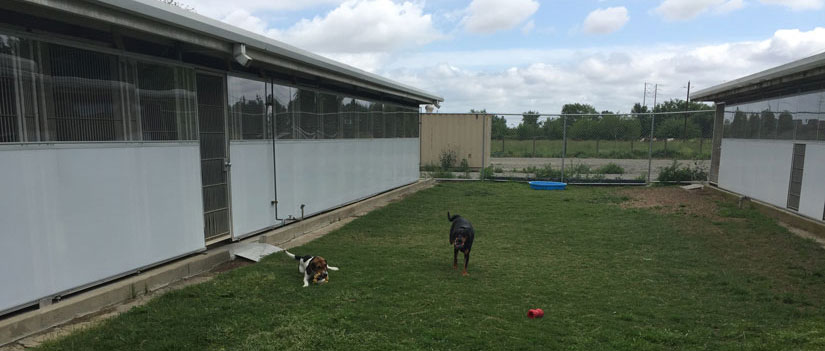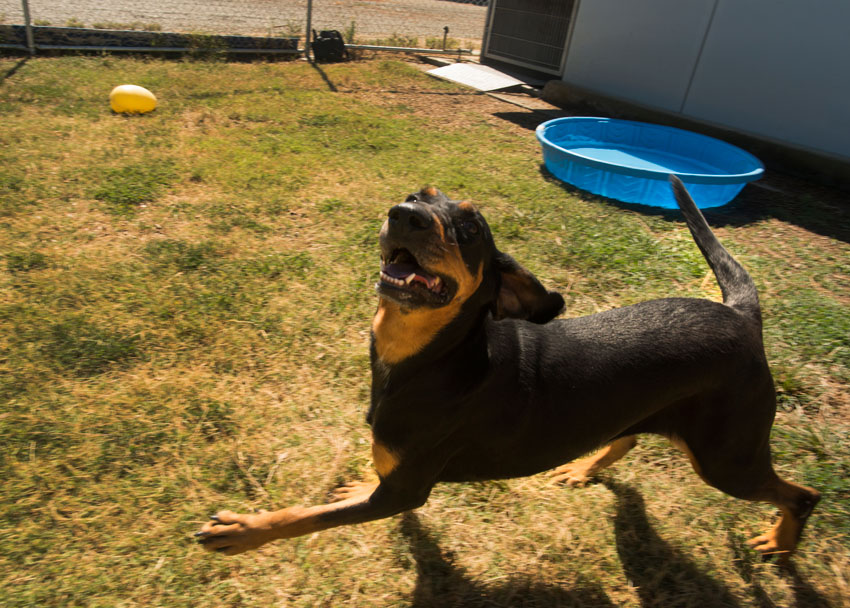Quick Summary
- Teaching and Research Animal Care Services team provides area where dogs can be dogs
- TRACS maintenance and Facilities Management build play yard between kennel buildings
- Study proves successful, as described in article in Laboratory Animal Science Professional
A team at TRACS, Teaching and Research Animal Care Services, is treating research dogs to an enriched environment, and telling other animal science lab professionals how they can do the same thing.
“Previously the dogs had no outside area to play in and no large area to run around,” the team wrote in an article that appeared in a recent edition of the journal Laboratory Animal Science Professional. “Besides their own pairing, there was no active social interaction between pairs or groups.”

So, staff suggested creating an exercise space between two kennel buildings — a space where the facility’s beagles and mixed-breed hounds could engage in such “doggy behavior” as running, jumping, digging and playing tug-of-war with toys.
The authors: Betty Ma, staff veterinarian; Jamie Green and Saleda Sizemore, veterinary technicians; Cheryl Pater, training and safety specialist; and Peter Vertz, associate director, TRACS Husbandry. They also acknowledged Monica Lowery for her input into the program.
The construction — by Burt Vannucci of TRACS maintenance; Edward Molina, a retired supervisor; and Facilities Management — entailed fence installation on both ends of the play area; and modifications to two kennels, one in each building, to allow for access to and from the space.

Of course, this being a research program, the TRACS team crafted a study of 11 dogs as they were carefully introduced to the new environment. “Although there were minor clinical issues with some of the dogs that used the exercise area, the benefits were far greater, since the dogs received plenty of exercise during their time in the play area,” states the article, titled "Variation on Providing Research Dog Enrichment."
The program requires “great care and close monitoring,” the authors wrote. Staff must ensure dogs are compatible with one another in the exercise yard; and the toys and yard must be cleaned before each group enters the exercise area.

'The dogs exhibit better interactions with people, positive responses to their names, and some basic command responses' — TRACS team
The exercise yard has helped the dogs become more playful and reduced stereotypies such as cage biting and pacing, according to the article. “The dogs exhibit better interactions with people, positive responses to their names, and some basic command responses.”
Further, the dogs are generally calmer when placed back inside their individual kennels, and, with less stress on them, the dogs react better as study subjects. “The dogs are much easier to work with as they are now allowed an outlet for energy.”
One last bonus: By allowing the dogs to engage in species-specific behaviors, and to interact more with people, they transition more smoothly from research animal to pet after adoption.
Media Resources
Dateline Staff, 530-752-6556, dateline@ucdavis.edu
